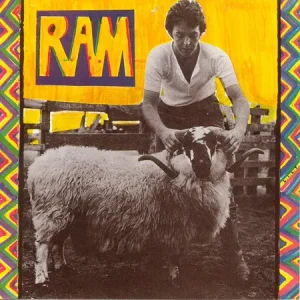Released in May 1971, “RAM” stands as a seminal piece in Paul and Linda McCartney’s collaborative discography. Nestled between the Beatles’ disbandment and the formation of Wings, “RAM” marks a pivotal moment in McCartney’s career. It represents a bridge between the highly orchestrated, studio-polished works of the Beatles and the more organic, homespun charm of his later projects. The album is a vibrant tapestry woven from threads of rock, pop, and folk, embodying a whimsical yet introspective spirit that diverges from McCartney’s previous work.
In the broader music landscape, “RAM” emerged during a time of significant evolution. The early ’70s saw rock music branching into various subgenres, with artists exploring new sonic territories. Amidst this backdrop, “RAM” distinguished itself with its eclecticism and unpretentious demeanor, offering a refreshing counterpoint to the increasingly experimental trends of the era.
Artistic Intentions
Paul and Linda McCartney’s artistic intentions with “RAM” were multifaceted. On one level, the album was a personal retreat into the solace of domestic life, a theme that resonates in its lyrics and pastoral soundscapes. McCartney aimed to capture the essence of simplicity and joy found in everyday moments, as evidenced by tracks like “Heart of the Country” and “Eat at Home.” Furthermore, “RAM” was an assertion of creative independence. Following the dissolution of the Beatles, Paul sought to redefine his musical identity, free from the expectations tied to his former band. The album’s playful experimentation and raw production underscore a desire to break from convention and forge a new artistic path.
Sonic Exploration

“RAM” is a masterclass in sonic exploration, showcasing Paul and Linda McCartney’s adventurous spirit and meticulous attention to detail. The production quality of the album strikes a delicate balance between polished and organic. Produced by Paul McCartney and engineered by Eirik Wangberg, the sound is crisp and clear, yet it retains a certain rawness that imbues the album with an intimate, homespun charm. This approach to production perfectly aligns with the album’s themes of domestic bliss and pastoral tranquility. It feels like an authentic glimpse into the McCartneys’ life, unvarnished and sincere.
Musical Arrangements
The musical arrangements on “RAM” are both innovative and eclectic. Paul McCartney, ever the master of melody, weaves together a rich tapestry of sounds that range from the whimsical to the profound. The album opens with “Too Many People,” a track featuring layered guitars, dynamic shifts, and a driving rhythm that sets the tone for the rest of the record. The arrangement is complex, yet it flows effortlessly, showcasing McCartney’s prowess in crafting intricate yet accessible compositions.
One of the standout tracks, “Uncle Albert/Admiral Halsey,” exemplifies the album’s playful and experimental nature. This medley, with its lush orchestration and shifting time signatures, creates a vivid auditory landscape. The brass sections, string arrangements, and quirky sound effects blend seamlessly, taking the listener on a whimsical journey. Linda McCartney’s harmonies add a distinctive texture, enhancing the song’s whimsical charm.
Genre Elements
Throughout “RAM,” the album touches upon a diverse array of musical genres and subgenres. There are elements of rock and roll, evident in tracks like “Smile Away,” with its gritty guitar riffs and boisterous energy. Folk influences permeate songs such as “Heart of the Country,” where acoustic guitars and rustic imagery evoke a sense of pastoral serenity. The track “Monkberry Moon Delight” dives into bluesy territory with its raw vocals and pounding piano, showcasing McCartney’s versatility.
“RAM” doesn’t just dabble in these genres; it blends them in a way that feels both cohesive and refreshing. The album’s eclectic nature is a testament to McCartney’s ability to transcend musical boundaries and create something uniquely his own. Tracks like “Long Haired Lady” and “Back Seat of My Car” further illustrate this genre-blending approach, combining elements of pop, rock, and baroque orchestration to create lush, multilayered soundscapes.
Lyrical Analysis

“RAM” delves deeply into a spectrum of themes and messages, painting a vivid lyrical landscape that ranges from the deeply personal to the whimsically abstract. Central to the album are themes of domestic bliss, pastoral tranquility, and the simplicity of everyday life, contrasted with subtle expressions of discontent and social commentary. These themes are intricately woven through the lyrics, creating a rich tapestry of storytelling and emotion.
One of the most prominent themes is the joy and contentment found in domestic life. Tracks like “Heart of the Country” celebrate the serene pleasures of rural living, with lyrics such as “I want a horse, I want a sheep, I want to get me a good night’s sleep.” This pastoral imagery reflects Paul McCartney’s desire for a simpler, more grounded existence following the tumultuous end of the Beatles. Similarly, “Eat at Home” exudes a sense of homely comfort and intimacy, capturing the essence of shared domestic life with Linda.
However, “RAM” is not without its moments of tension and critique. “Too Many People” serves as a veiled commentary on the disarray and discontent following the Beatles’ breakup, with lines like “Too many people preaching practices, don’t let them tell you what you wanna be.” This track, among others, showcases McCartney’s ability to infuse his lyrics with layered meanings and personal reflections, often open to interpretation but grounded in his own experiences.
Lyrical Depth
The lyrical depth of “RAM” is notable for its balance between straightforward narrative and poetic abstraction. While some songs tell clear, simple stories—such as “Uncle Albert/Admiral Halsey,” with its whimsical tale of British eccentricity—others are more ambiguous and open-ended. “Monkberry Moon Delight,” for instance, is a surreal stream-of-consciousness piece filled with vivid, nonsensical imagery that invites various interpretations. Lines like “So I sat in the attic, a piano up my nose, and the wind played a dreadful cantata” showcase McCartney’s flair for creating evocative, dreamlike scenes.
Emotional Impact
The emotional impact of the lyrics on “RAM” is profound, contributing significantly to the album’s overall resonance. The sincerity and warmth in songs like “Ram On” and “Long Haired Lady” evoke feelings of joy and nostalgia, drawing listeners into McCartney’s intimate world. Conversely, tracks with a more critical or melancholic tone, such as “Dear Boy,” elicit empathy and reflection, revealing the complexities of McCartney’s thoughts during this transitional period.
Moreover, the playful and sometimes absurd nature of the lyrics adds an element of joy and whimsy to the album. This is particularly evident in “Smile Away,” where the lighthearted, almost tongue-in-cheek approach to the lyrics brings a sense of fun and spontaneity. Even in its most abstract moments, the album maintains an emotional accessibility that resonates with listeners, making it both a deeply personal and universally relatable work.
Cohesion and Flow

“RAM” is a masterfully crafted album where each track seamlessly transitions into the next, creating a cohesive and immersive listening experience. The album’s flow is a testament to Paul and Linda McCartney’s careful curation and thoughtful sequencing of songs, ensuring that the listener is taken on a journey that is both emotionally and narratively engaging.
Track Progression
The album’s progression is remarkably fluid, with each song naturally leading into the next. “Too Many People” sets the stage with its energetic and slightly confrontational tone, reflecting McCartney’s feelings post-Beatles. This momentum is carried forward into “3 Legs,” which continues the critique in a more bluesy, laid-back style. The shift from the raw energy of these opening tracks to the serene “Ram On” introduces a gentler, more introspective phase of the album, showcasing McCartney’s ability to balance different moods within a single project.
As the album unfolds, the juxtaposition of songs like “Dear Boy” and “Uncle Albert/Admiral Halsey” illustrates McCartney’s skill in mixing introspective lyrics with whimsical storytelling. The latter, with its multi-part structure, serves as a central pivot in the album, merging various musical ideas and themes. This track, with its playful shifts and eclectic instrumentation, bridges the first and second halves of the album, maintaining listener interest and variety.
The latter part of the album, featuring tracks like “Heart of the Country” and “Monkberry Moon Delight,” continues to blend different styles while maintaining a consistent thematic thread. The closing tracks, particularly “The Back Seat of My Car,” bring the album to a satisfying conclusion, weaving together the emotional and musical motifs introduced earlier. The final track’s lush orchestration and emotional depth leave the listener with a sense of closure and completeness.
Thematic Consistency
“RAM” excels in maintaining thematic and stylistic consistency throughout its runtime. The overarching themes of domestic bliss, personal reflection, and whimsical escapades are threaded through each song, creating a unified narrative. Even as the album explores different genres and moods, from the pastoral folk of “Heart of the Country” to the surreal blues of “Monkberry Moon Delight,” the core themes remain intact.
The stylistic shifts between tracks are handled with finesse, ensuring there are no jarring transitions that could disrupt the album’s flow. For instance, the move from the introspective “Ram On” to the buoyant “Smile Away” is smooth and natural, highlighting McCartney’s adeptness at pacing and sequencing. Each track, while distinct in its own right, contributes to the album’s overall tapestry, enhancing the sense of a cohesive artistic vision.
Moreover, the recurring motifs and lyrical callbacks throughout the album reinforce its unity. References to rural life, personal anecdotes, and playful nonsense recur in various forms, creating a sense of continuity and depth. Linda McCartney’s harmonies and vocal contributions also serve as a unifying element, adding a layer of consistency to the album’s sound.
Standout Tracks and Moments
“RAM” is filled with standout tracks and memorable moments that highlight Paul and Linda McCartney’s artistry and creativity. Each track offers something unique, but a few particularly shine for their innovation, emotional depth, and artistic merit.
Key Tracks
“Too Many People”: This opening track immediately grabs attention with its energetic guitar riffs and pointed lyrics. It’s a subtle yet sharp critique of the societal pressures and personal conflicts that followed the Beatles’ breakup. The track’s dynamic shifts and layered production set the tone for the album’s diverse soundscape.
“Uncle Albert/Admiral Halsey”: Perhaps the most iconic track on “RAM,” this medley showcases McCartney’s genius for blending multiple musical ideas into a cohesive whole. The song’s whimsical narrative, lush orchestration, and playful shifts in tempo and style make it a standout piece that exemplifies the album’s eclectic nature.
“Heart of the Country”: This track epitomizes the album’s pastoral charm, with its simple yet evocative lyrics celebrating rural life. The acoustic guitar, paired with McCartney’s warm vocals, creates a serene, comforting atmosphere. It’s a heartfelt ode to finding peace and joy in the simplicity of nature.
“Monkberry Moon Delight”: A wild and surreal journey, this song features some of the album’s most vivid and imaginative lyrics. McCartney’s powerful, gritty vocal performance and the song’s bluesy, boisterous instrumentation make it a memorable highlight that showcases his willingness to experiment.
“The Back Seat of My Car”: Closing the album with emotional and musical grandeur, this track is a tour de force of orchestration and lyrical storytelling. Its sweeping arrangements and heartfelt lyrics about young love and adventure make it a fitting, climactic end to the album.
Memorable Moments
“Ram On”: The gentle ukulele strums and McCartney’s soothing voice create an intimate, almost meditative moment. The reprise later in the album serves as a reflective pause, reinforcing the themes of simplicity and contentment.
“Dear Boy”: The intricate harmonies between Paul and Linda, coupled with the track’s lush production, make this song a standout. The lyrics, rumored to be a message to John Lennon, add a layer of personal significance and emotional depth.
“Uncle Albert/Admiral Halsey” (middle section): The transition from “Uncle Albert” to “Admiral Halsey,” marked by a brass fanfare and a jaunty, sea shanty-like rhythm, is one of the album’s most delightful moments. The seamless blending of these contrasting sections highlights McCartney’s compositional prowess.
“Monkberry Moon Delight” (vocal performance): McCartney’s raw, almost unhinged vocal delivery on this track is a highlight. His voice, strained and powerful, conveys a sense of wild abandon that perfectly matches the song’s surreal lyrics.
“The Back Seat of My Car” (climax): The orchestral build-up and McCartney’s soaring vocals in the final moments of this track are truly breathtaking. The emotional intensity and musical complexity here encapsulate the essence of “RAM” as a whole—ambitious, heartfelt, and richly textured.
Artistic Contribution and Innovation

Place in Genre/Industry
“RAM” occupies a unique and influential position within the music industry and the broader rock genre. Released in 1971, during a time of significant musical evolution, the album defied easy categorization, blending elements of rock, pop, folk, and even proto-indie influences. It was a period marked by the rise of progressive rock, the emergence of singer-songwriters, and the continued dominance of psychedelic sounds. Against this backdrop, “RAM” stood out not only for its eclecticism but also for its unapologetic embrace of domestic and pastoral themes.
The album’s release followed the tumultuous breakup of the Beatles, positioning Paul McCartney in a crucial phase of re-establishing his identity as a solo artist. “RAM” diverged from the more polished and orchestrated productions of the Beatles, presenting a raw, homespun quality that resonated with listeners seeking authenticity amidst the growing complexity of contemporary rock music. It contributed to the broader movement towards a more personal and introspective style of songwriting that would become a hallmark of the 1970s.
Innovation
“RAM” is notable for several innovative aspects that set it apart from its contemporaries and solidified its place as a groundbreaking work in Paul McCartney’s career.
Production Approach
The album’s production style is a blend of high fidelity and lo-fi aesthetics. While meticulously produced, it retains a raw, almost demo-like quality that gives it an intimate feel. This approach was relatively unconventional at the time, especially for an artist of McCartney’s stature, and it contributed to a sense of authenticity and spontaneity that many listeners found refreshing.
Genre Blending
“RAM” deftly navigates a multitude of genres, incorporating rock, folk, pop, and even hints of blues and proto-indie. This genre-blending was innovative not only in its seamless integration of different musical styles but also in how it set a precedent for future artists to explore and merge diverse influences without being confined to a single genre.
Collaborative Spirit
The prominent role of Linda McCartney on the album was a forward-thinking move that highlighted the collaborative nature of the project. Her vocal harmonies and contributions to the songwriting process added a unique texture and depth to the album, showcasing the potential for spousal partnerships in music. This dynamic paved the way for more inclusive and collaborative approaches in the industry.
Thematic Exploration
“RAM” broke new ground with its thematic focus on domestic life and pastoral tranquility. At a time when rock music often centered on rebellion, existential angst, and urban themes, McCartney’s celebration of rural simplicity and domestic contentment was both innovative and subversive. This thematic shift opened up new avenues for songwriting, emphasizing that the everyday experiences of life could be just as compelling as the grandiose themes traditionally explored in rock music.
Experimental Song Structures
Tracks like “Uncle Albert/Admiral Halsey” exemplify McCartney’s willingness to experiment with song structure, creating multi-part compositions that weave together different musical ideas and narratives. This approach to songwriting, which mixes various sections and moods within a single track, was innovative and ahead of its time, influencing future artists who sought to push the boundaries of conventional song formats.
Closing Thoughts

“RAM” by Paul and Linda McCartney stands as a testament to creative freedom and artistic innovation. Its strengths are manifold: a rich tapestry of diverse musical genres, intimate and authentic production, and a blend of whimsical and profound lyrical themes. The album’s unique charm lies in its seamless integration of domestic bliss and pastoral tranquility with more critical and introspective moments. Paul McCartney’s ability to craft intricate yet accessible melodies, combined with Linda’s harmonious contributions, creates an album that feels both expansive and personal.
The production quality of “RAM,” which balances high fidelity with a raw, homespun feel, sets it apart from other albums of its era. The eclectic nature of the musical arrangements, ranging from the playful medley of “Uncle Albert/Admiral Halsey” to the surreal bluesy vibes of “Monkberry Moon Delight,” showcases McCartney’s versatility and willingness to push boundaries. The lyrical depth, oscillating between straightforward storytelling and abstract imagery, adds layers of meaning and invites multiple interpretations.
However, the album is not without its weaknesses. Some critics might argue that its eclectic nature can feel disjointed at times, and the whimsical elements may not appeal to all listeners. Yet, these perceived weaknesses are also what give “RAM” its distinctive character and enduring appeal. The album’s willingness to embrace variety and experimentation is precisely what makes it a significant work in McCartney’s discography.
Place In Career
In terms of its impact on listeners, “RAM” offers a deeply personal and relatable experience, resonating with those who appreciate music that captures the joys and trials of everyday life. Its place in Paul McCartney’s career is pivotal, marking a period of artistic reinvention and independence following the Beatles’ breakup. The album’s influence extends beyond its initial release, inspiring future artists to explore the intersections of different genres and the beauty of simplicity in songwriting.
Official Rating
Given its artistic merit, innovative approach, and emotional depth, “RAM” deserves a perfect rating. I would rate it a 10 out of 10. This rating reflects not only its excellence as a standalone work but also its significance in the broader context of music history. “RAM” is a timeless album that continues to captivate and inspire, embodying the creative spirit of Paul and Linda McCartney at their best.
